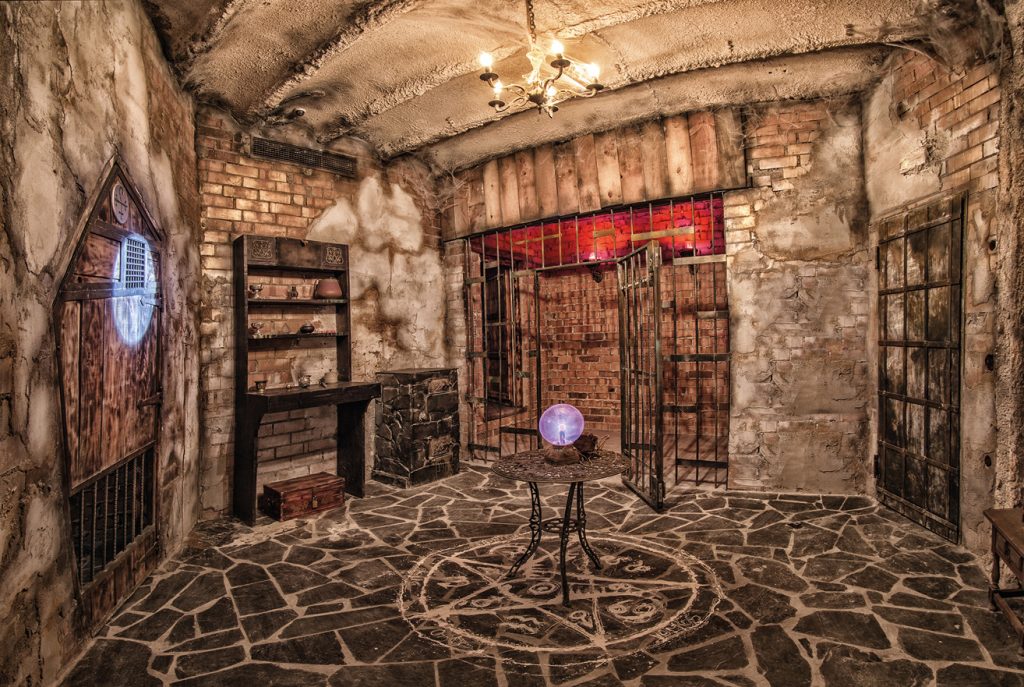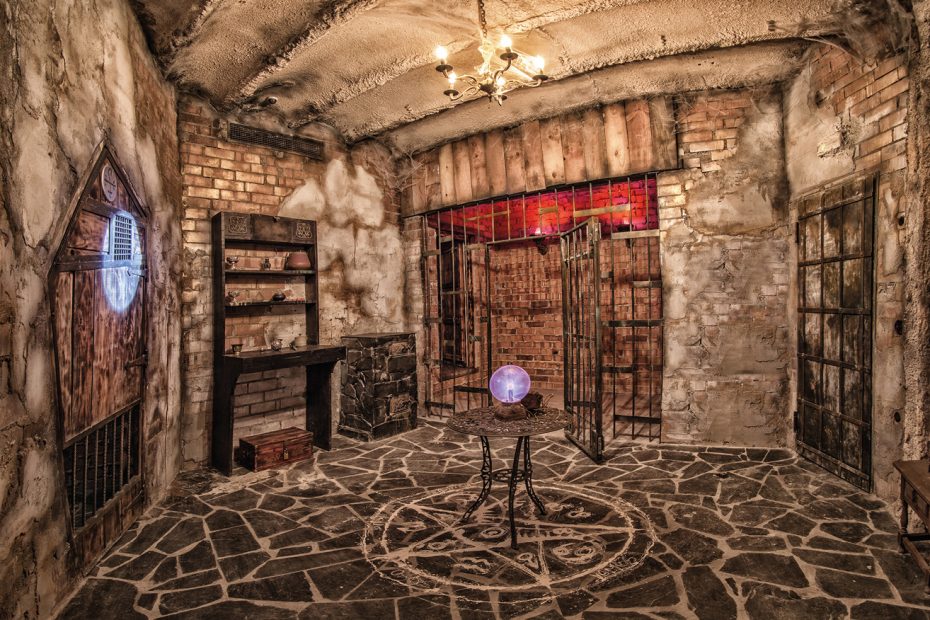
Escape rooms are a fun, interactive way to bring a group together. A challenging escape room requires teamwork, problem-solving, and resiliency for any group that passes through.
So how do you design the perfect escape room like all those ones you’ve found through Morty? Below, we detail the critical elements that make an escape room mesmerizing to an audience. We also provide alternatives and suggestions on how you can integrate them into your final puzzle.
A Theme That is Tailored to the Audience
Before creating your escape room, you must ask yourself: “who is the target audience?” Your escape room should not only challenge participants but should also provide a comfortable environment for them.
There are several directions you can go with design. You can build an escape room that favors a family-friendly audience – like a Harry Potter theme, for example.
On the other hand, you could create a horror-driven escape room with dark twists and turns. You’ll want to avoid scary, gory elements for a family with small children. But if your target audience is high-level escape room enthusiasts, you can let loose and create an escape room that’s extra challenging.
An Exciting Location
The actual building that hosts the escape room is important. The venue sets the stage and builds a particular atmosphere, depending on its design and size. For some locations, you might rent out a single floor in the middle of an office building (which is practical but not too exciting). On the other hand, a multi-level space with twists and turns will be more exciting but perhaps harder to maintain.
You also want to keep in mind how your customers will find the escape room business. They will navigate your escape room when they arrive. Your participants do not need to endure another puzzle in finding your location!
An Intriguing Storyline and Puzzle Concept
The storyline is the backbone of the escape room. It will determine the success of the challenge, the level of guest engagement, and their sense of accomplishment.
Any narrative should match your theme and your physical space. A multi-level escape room might have a different storyline than a single-floor challenge. As you build up your story, assess the physical space by determining the possibilities, limitations, and safety hazards.
You also need to make your story believable. The ideal one should form an immersive world as a video or computer game does. It will have intriguing characters, elements, and tiny details.
There also needs to be an end goal in mind that will feel worthwhile to participants. This ideal outcome should be clear and understandable for the characters, featuring multiple obstacles and challenges along the way.
The story could feature a primary protagonist who acts as a fictional ally for the team. This protagonist might be an explorer, treasure hunter, or other playful character. You do not necessarily need to spend a lot of time on character details, as long as it’s believable for the participants.
Sophisticated Room Design, Pace, and Flow
An escape room should be challenging, but it should also feature flow and movement. There will likely be numerous groups that come through your escape room in a single day. You want to engage each one, but you also want to make sure you keep things moving.
Ultimately, it all comes down to two plot choices: a multilinear or linear concept. The story and physical space will play a large part in this decision.
A linear puzzle will be a straightforward, direct combination of puzzles to escape. One room will lead to another, and there will be a single answer or solution for each stage (and sometimes there are multiple potential answers). If you anticipate having a high volume of participants pass through your escape room in a given day, you should lean more toward this style.
On the other hand, a multilinear puzzle is more complex and intense – perfect for escape room fanatics. Much like the movies Interstellar and Inception, the puzzle can have various paths to reach the final destination. A multilinear puzzle will challenge the group to think outside the box even more than usual. But this puzzle type might incentivize a slower pace for participants, so that is something essential to consider when setting goals for daily visitor numbers.
Challenging (But Solvable) Puzzles
When you design an escape room puzzle, you should set it at a difficulty level that will satisfy a wide range of people. You want the escape room to present a meaningful challenge. However, you do not want people to get frustrated and want to quit when they cannot figure things out.
Gaining feedback is critical in the escape room planning stages. Once you form the final concept, send it out to a focus group (that can consist of your puzzle-loving family and friends) to determine if the idea represents a good challenge. It is critical to do this before you invest the money to build and set up the space.
Mysterious Hints that Build Intrigue
Another alternative to reduce the difficulty of the escape room is through hints and clues. Mysteries are inherently appealing. Enigmatic hints will not only engage the audience, but will also satisfy all levels of escape room expertise. Of course, seasoned escape room veterans might not need the clues. But a team of rookies will benefit from extra assistance along the way.
The hints should provide new information, but they should not answer everything right away. Make sure you implement different types of clues to keep things interesting. Some can be handwritten while others can be verbal. You could also insert clues that direct people toward a specific prop.
Acknowledgment of Pop Culture, Movies, and Games
Another effective way to engage the audience is by giving a nod to pop culture, movies, and games.
Doing so will show that you did your research and pander to the audience in an organic way. Familiarity is a massive factor in participant engagement, so you should sprinkle these acknowledgments throughout the escape room.
Movies like James Bond and Indiana Jones are perfect examples. Consider setting up props, character voices, and other elements that remind people of classic mystery and adventure films. If you wanted to go all out, you could even base the entire theme on something from pop culture so you can attract its fans. Use an escape room app to see what’s popular and help you come up with ideas.
Differentiable Entry and Exit Points
To keep people on their toes, you can always design a unique entry and exit point for each room. Taking this approach will keep the audience fresh and motivated. If the participants open and close the same door over and over, they might get bored.
There are many ways to have fun with the entry and exit points of an escape room. You can create a maze of passages, doors, rooms, and chambers that have different themes. Depending on the challenge of a room, you can have entry and exit points that match the environment. If you want to go the extra mile, you could even mix in a secret door.
Fun Props in Each Environment
Escape rooms can get boring if they’re only puzzles in a bunch of rooms. To avoid that, add fun props, decorations, and elements. These props and elements must align with the theme and add to the mysteriousness of the escape room experience. Any items that do not fit will stick out and make the escape room less interesting.
As you set up the props throughout the puzzle, they should also be unique for each room. You do not want to lay out repetitive props throughout the puzzle because it could make the journey boring and predictable.
Integrated Technology
The presence of technology is another decision you will need to consider when you build the escape room. Depending on what your existing storyline is, you might just want to keep it traditional and leave technology out.
However, some audiences can appreciate the presence of technology. A couple of examples of technology to mesmerize the audience include:
- Tablets in each room featuring essential puzzles, clues, or questions
- Sound effects that help immerse participants in the game
Complete Game Immersion
When your participants step into your escape room, they should feel like they are in a different world. The next hour should take them away from their regular life and immerse them in a unique challenge.
Every design feature described in this article should contribute to this feeling of immersion. After all, it is called an “escape” room for a reason.
Keep People Guessing Until Game Completion
Lastly, the most mesmerizing thing about an escape room is the element of unpredictability. The best escape rooms will keep participants guessing down the stretch. You establish this unpredictability through the storyline and its twists and turns. As you build the storyline, you should define the elements of surprise.
However, you should account for the fact that people may not work through the room exactly as you intend. Make sure that failure is acceptable throughout the escape room experience. If groups are consistently finishing your escape room in less than thirty minutes, you should evaluate the difficulty level.
Final Wrap Up
At the end of the day, people want to feel challenged. They also want to have fun and build a bond with their group. Through innovative storylines, room designs, and clues, you can help people accomplish this goal. There are countless things you can do to enhance an escape room.
Find inspiration and bring your designs to the world with a quality escape room app like Morty. Doing so can transform your experience and ensure everyone has an unforgettable time. Download the app and start browsing today to find your next escape room muse!
